pine trees details atmospheric perspective art drawings silueta
The Scientific Eye and Visual Wonders in Edo
March 29 to May 11 2014
*There will be an exhibition change during the course of exhibition
- Exhibition Overview
- Works from the exhibition
Section 1
The Encounter with Linear Perspective
Western perspective techniques, which were backed by scientific theory, had significant influence on a variety of artists in Japan. Okumura Masanobu, Utagawa Toyoharu, Katsushika Hokusai, Utagawa Hiroshige and others produced a great number of uki-e , pictures created using one-point perspective (linearperspective) techniques, that survive today. One-point perspective was devised in the West as a way to express, on a flat surface,the sense of distance from a fixed point to a viewed object. By the latter half of the Edo period, it had also gained currency in Japan. One of its applications was the megane-e , a type of picture designed to seen through a viewing apparatus or optique; the work of megane-e artist Maruyama Okyo, for example, achieved great popularity.
One outcome of these trends was the emergence of Akita Ranga , a school of Western-style painting created by Odano Naotake and other members of the warrior class from the Akita domain. They established a distinctive expression of perspective by adopting a Western style of painting, the technique of rendering objects in the foreground as large and the background small,and the use of aerial perspective, in which depth is rendered by presenting the foreground in distinct colors and the background in fainter colors with weaker contrasts. Shiba Kokan, who learned the techniques of Western-style painting from Naotake, succeeded in producing copperplate etchings that contributed to the spread of Western-style painting. Aodo Denzen, whose talents were discovered by Matsudaira Sadanobu, the Shirakawa daimyo , also worked tirelessly, with Sadanobu's support, to produce copperplate etchings.
This section introduces the many ramifications of linear or one-point perspective through the work of artists working in a wide range of genres.
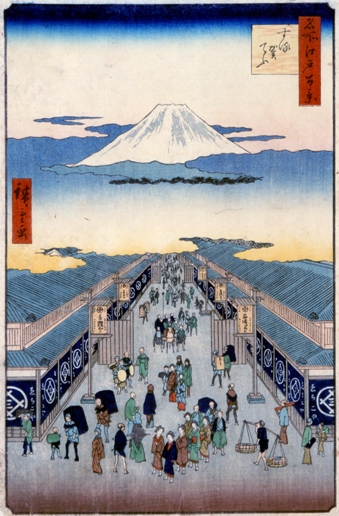
One Hundred Famous Views of Edo: Suruga-cho
Utagawa Hiroshige
Ansei 3 (1856)
Private collection
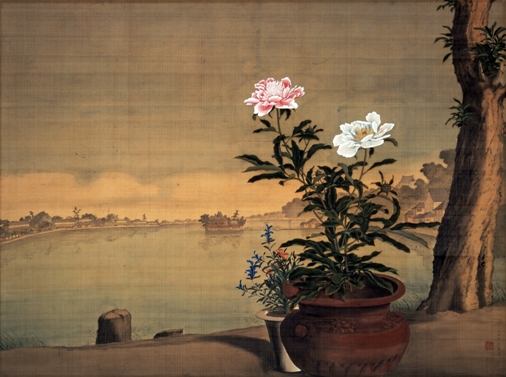
Important Cultural Property
Shinobazu Pond
Odano Naotake
Color on silk
1770s
Akita Museum of Modern Art
Section 2
Artists with a Bird's-eye View
The bird's-eye view (overhead view), looking down on the land from the sky, the most suitable technique for representing terrain, had long been used in depictions of famous places and shrines and temples in Japan. By the latter half of the Edo period,the incorporation of one-point perspective and other techniques produced paintings using a bird's-eye view based on a more accurate representation of distance.
The art of creating bird's-eye view images is closely related to map-making, and astronomical observation using a telescope was essential for producing accurate maps. Invented in the late sixteenth century in the West, telescopes soon reached Japan; by the eighteenth century, they had started to come into popular use.
Misemono (exhibits, shows, or spectacles) that charged spectators for looking through telescopes appeared, and an increasing number of people owned telescopes for their own amusement.Telescopes were also depicted in paintings and ukiyo-e.This section introduces bird's-eye view pictures by artists exercising their powers of imagination and works that depict the surge in the interest in telescopes and the new vision of the world they provided.
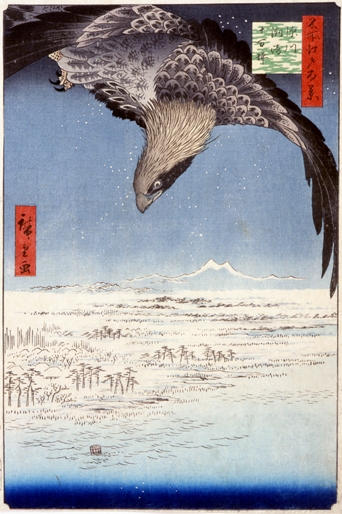
One Hundred Famous Views of Edo: Fukagawa Susaki and Jumantsubo
Utagawa Hiroshige
Ansei 4 (1857)
Private collection
Section 3
Seeing the Micro World through Microscopes
Microscopes were invented in the Netherlands at the end of the sixteenth century and reached Japan by the middle of the eighteenth century. By the latter half of the Edo period,microscopes were also being produced in Japan, attracting particularly strong interest among daimyo and Western-studies scholars. People also started to become aware of information based on observations through the microscope, such as magnified
drawings of fleas, mosquitoes, and other insects, or even snowflakes. Those images took off in many directions, even becoming incorporated in textile patterns, for example.
This section introduces works that convey how astonished people were at the complete transformation of what they had regarded as familiar sights, such as insects, snow, or other natural phenomena, when they looked through the lens.
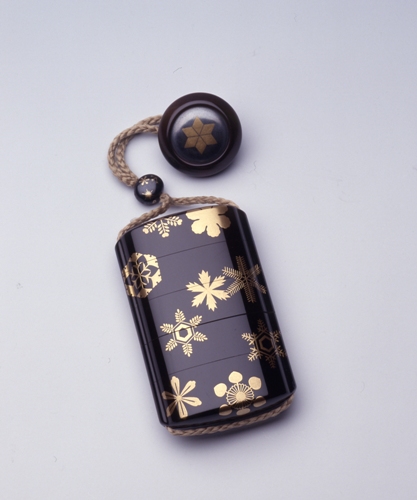
Important Cultural Property
Inro (Small Nested Caddy) with Snowflake Design
in Makie
Hara Yoyusai
Lacquer on wood
Tenpo 3-11 (1832-1840)
Koga City Museum of History
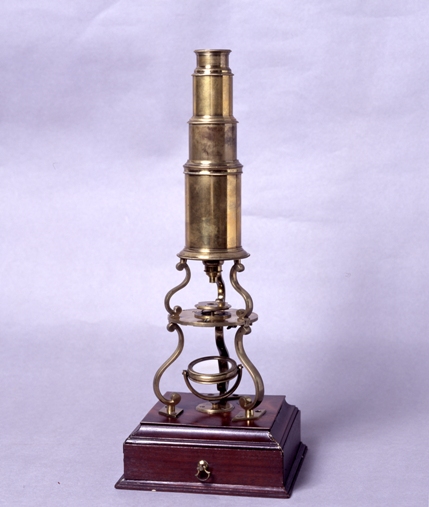
Culpeper Microscope
Metal、Wood
Ca.1737
Union Optical Co., Ltd.
(deposited with Koga City Museum of History)
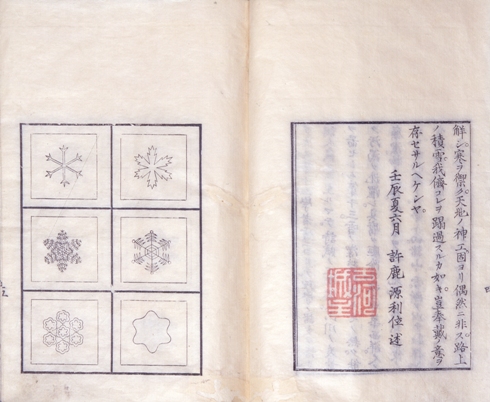
Illustrations of Snowflakes
Doi Toshitsura
Wood block print, ink on paper
Tenpo 3 (1832)
Koga City Museum of History
Section 4
Natural History Observation
Drawing from life by observing and sketching flora or fauna had been practiced in Japan well before the early modern period(1568-1868). By the latter half of the Edo period, with interest in the natural sciences rising under the influence of Western natural history studies, the production of realistic sketches from nature grew explosively. Unlike traditional bird-and-flower painting, for which artists emulated sketches made for future study, these drawings, classifying the flora and fauna of the natural world and providing the names of their subjects and explanations of their distinctive characteristics, were strongly reminiscent of the illustrations in natural history books. Many of these true-tolife drawings, however, are also exquisitely beautiful objects well worthy of appreciation as works of art.
This section introduces unique drawings from life created in the latter half of the Edo period, drawings that emerged when artistic appreciation overlapped with the research objectives of natural history.
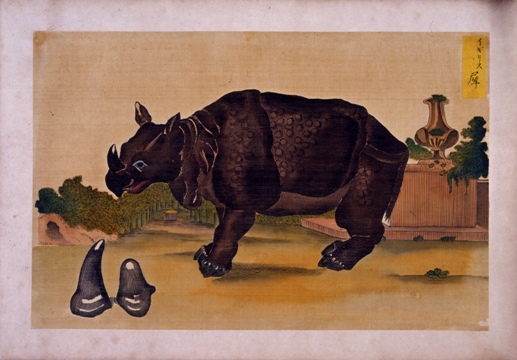
A Botanical Sketchbook
Sakamoto Konen
Color on silk
Tenpo 4 (1833)
Iwase Bunko Library
Section 5
Drawing Light and Shadow—Shadow Pictures, Saya-e , Mirrors, and Water
In the latter half of the Edo period, interest in optical phenomena spurred a growing awareness of light and shadow, and artists produced numerous works on this theme. Shadow pictures used clever ideas for representing the subject in silhouette by observing shadows through, for example, shoji doors. A related type of humorous picture, the yose-e , is a composite image created by combining multiple images arranged to produce a larger form. Utagawa Kuniyoshi was one of the artists who took yose-e to new heights. Artists also produced many saya-e , distorted pictures that appear normal only when viewed on a curved surface, and paintings that focused on images reflected in mirrors or on the surface of water. Clearly, scientifically calculated visual effects became an important element in pictorial representation.
This section introduces works that convey the mysteries of the sense of sight displayed through the wealth of ideas and keen powers of observation of Edo-period artists capturing light and shadow.
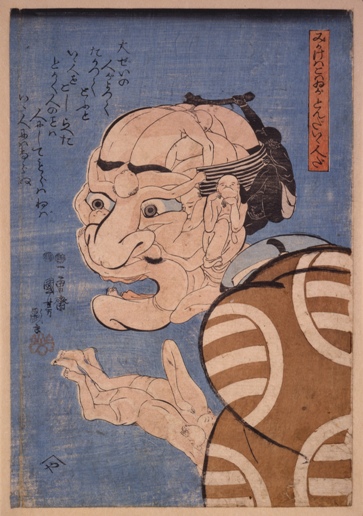
He Looks Fierce, But He Is Really a Nice Person
Utagawa Kuniyoshi
Ca. Koka 4 (1847)
Machida City Museum
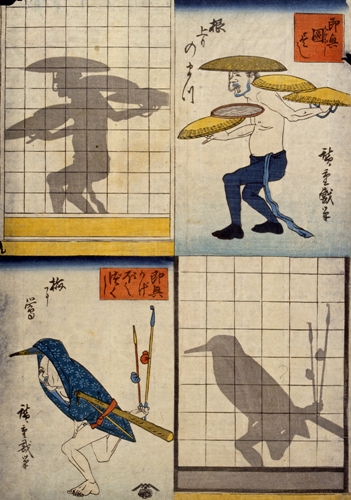
Impromptu Shadows: Pine Tree with Raised Roots and Warbler in a Plum Tree
Utagawa Hiroshige
Tempo era (1830-44)
Suntory Museum of Art
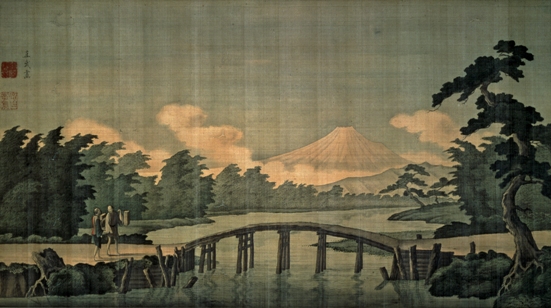
Tangible Cultural Property designated by Akita Prefecture
View of Mt. Fuji
Odano Naotake
Color on silk
Ca. An'ei 6 (1777)
Akita Museum of Modern Art
*Unauthorized reproduction or use of texts or images from this site is prohibited.
- Exhibition Overview
- Works from the exhibition
brownsaistopen1946.blogspot.com
Source: https://www.suntory.com/sma/exhibition/2014_2/display.html
0 Response to "pine trees details atmospheric perspective art drawings silueta"
Postar um comentário